Search Contents
2022 NECO BIOLOGY SOLUTIONS – QUESTIONS AND ANSWERS – Correct Answers

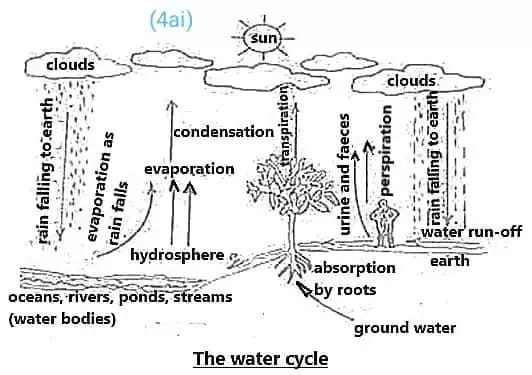
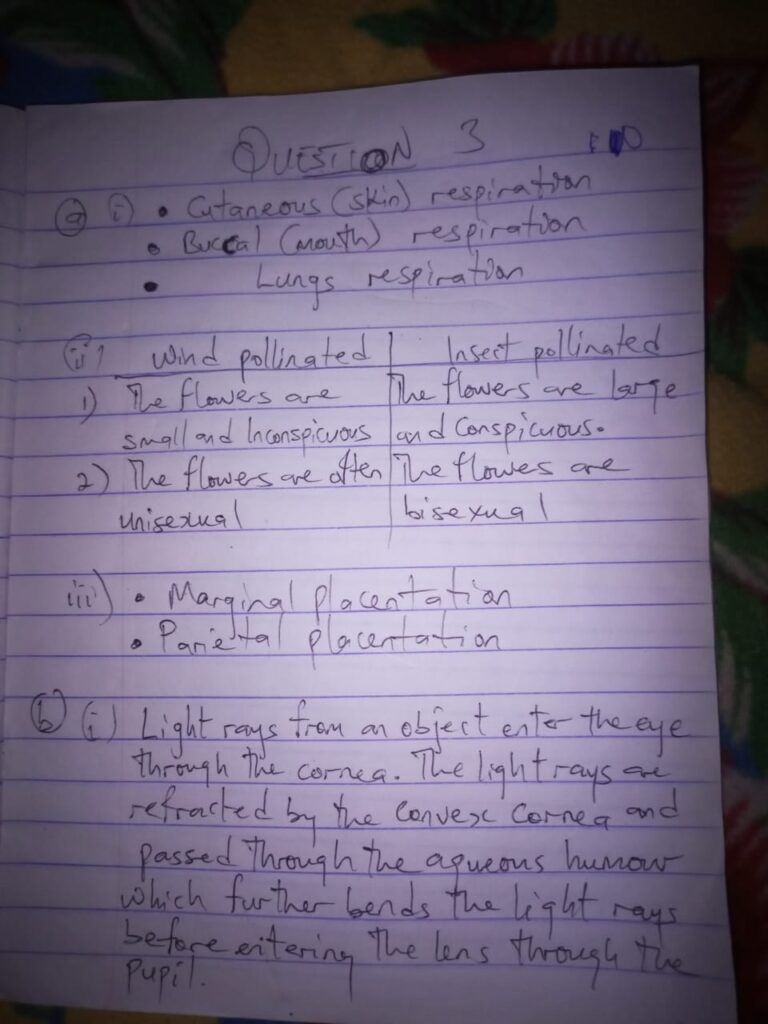
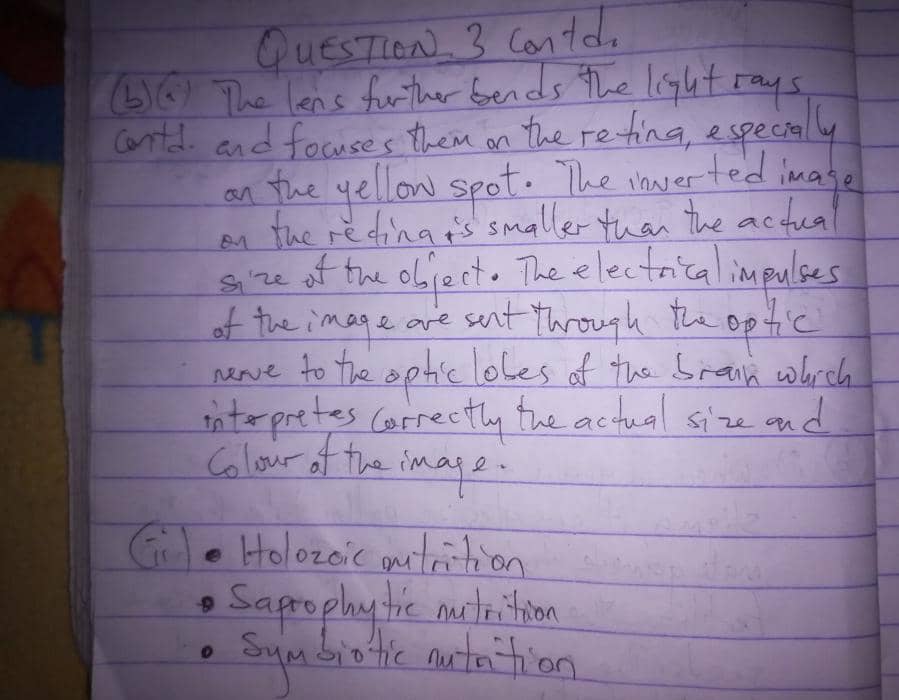
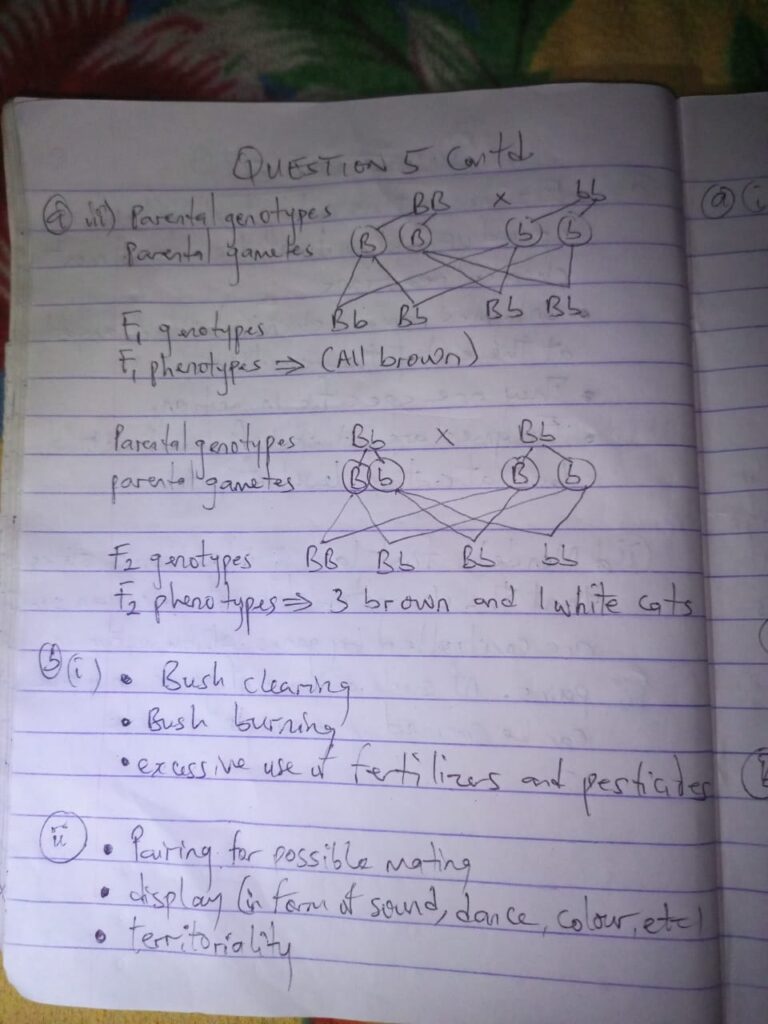
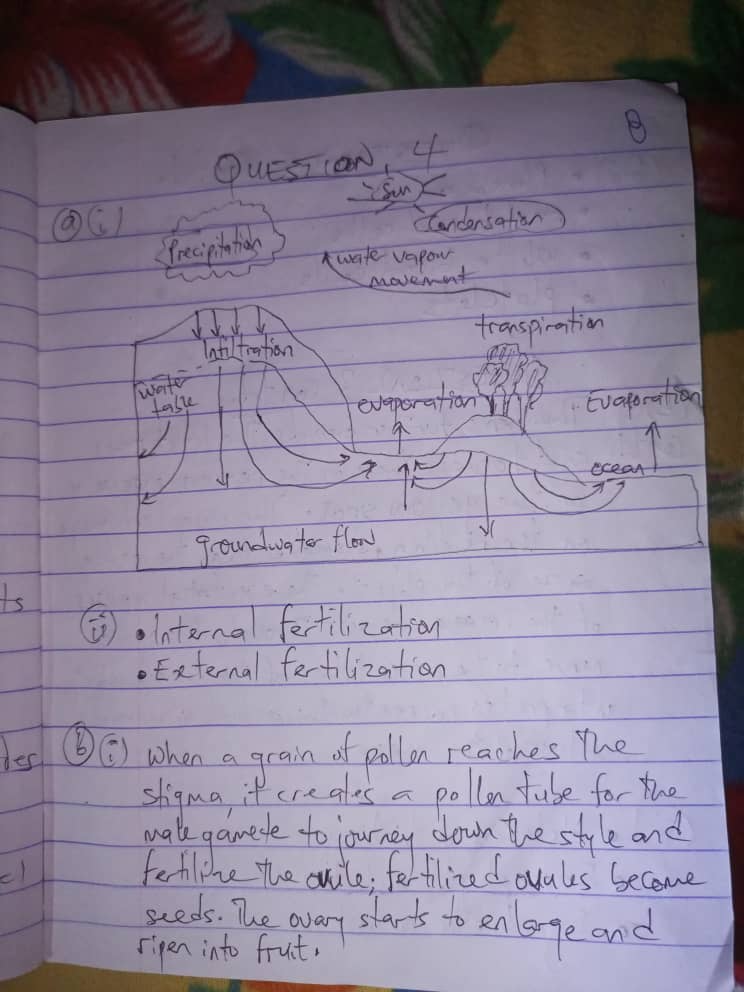
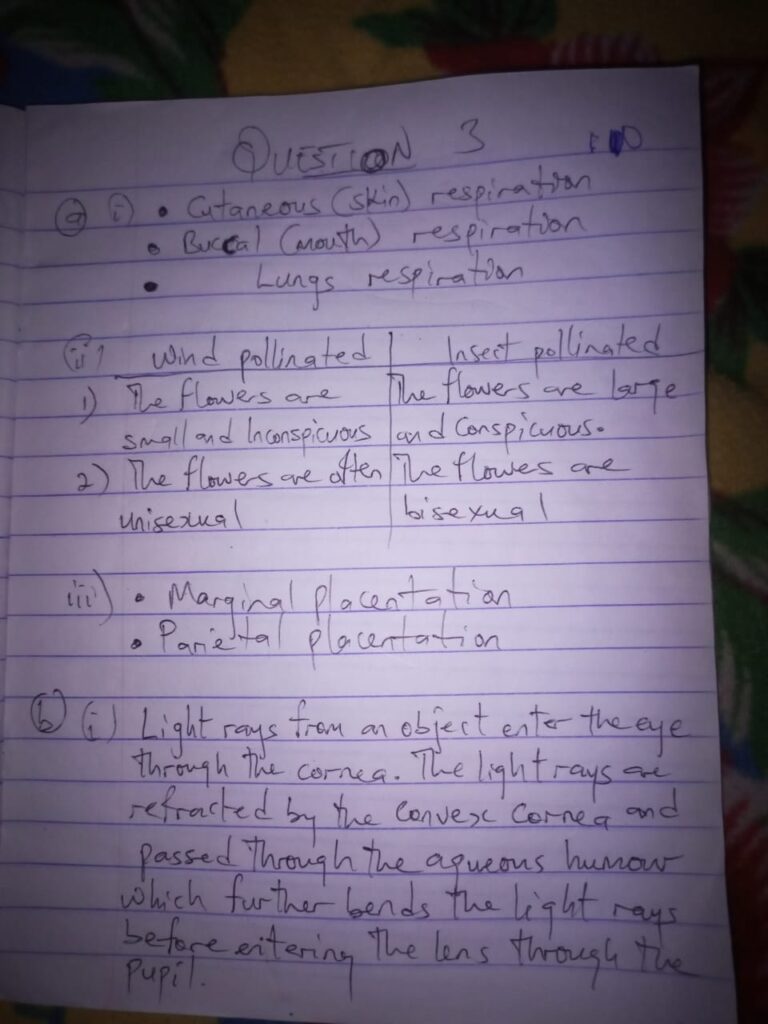
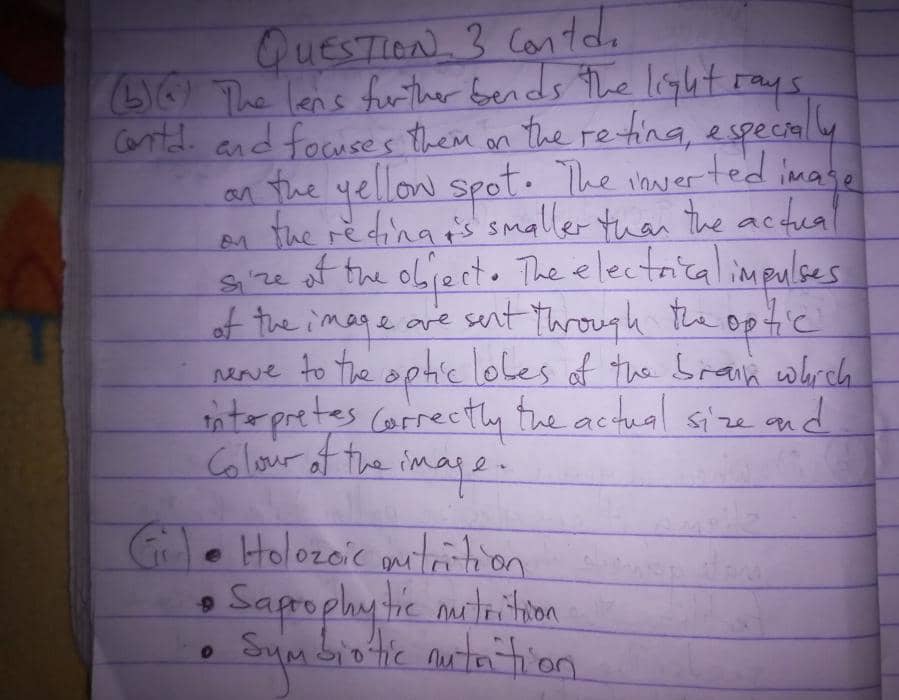
2022 NECO BIOLOGY SOLUTIONS – QUESTIONS AND ANSWERS – Correct Answers
BIOLOGY OBJ
1-10: DDEDBAEACC
11-20: DEECCBBBAB
21-30: EEADEAEAEA
31-40: BCCBCCBADE
41-50: DCCBCBECDC
51-60: EABBCCBADE
*INSTRUCTIONS*
_(Answers THREE Questions Only_
*(NUMBER ONE)*
(1ai)
(i) Setting up of national park and gardens to save wildlife in their natural environment.
(ii) Poaching i.e. uncontrolled and illegal killing of game should be prevented.
(iii) Avoiding the use of pesticides that may kill off many animals
(vi) Prohibiting deforestation and encouraging afforestation
(1ii)
Sexual reproduction involves the fusion of two gametes – male and female gametes during fertilization to form a zygote which develops into a new organism. It involves organisms of the same species.
Or
Sexual reproduction is the fusion or joining of male and female gametes or nuclei from different individual to form a zygote which later develops into an embryo or organism.
(1aiii)
(i) biceps (flexor)
(ii) Triceps (extensor)
(1b)
– When one touches a hot object, the sensory receptor in the skin receives the stimulus
– An impulse is transmitted from the receptor to the spinal cord, via the dorsal root/sensory neurone
– The intermediate neurone in the spinal cord passes on the impulse to the motor neurone
– The motor neurone then sends the impulses to an effector organ (muscle) via the ventral root
– All the neurones are linked by synapses across which impulses are sent
– The muscle upon receiving the impulse contracts causing the hand to be withdrawn from the hot object
(1ci)
(Pick Any Three)
(i) It provides water for photosynthesis
(ii) To get rid of excess water in the plant
(iii) It helps plants to continually draw water from the soil into their stem and leaves.
(iv) Some evaporation of water uses latent energy from plants and therefore keeps the plant cool
(v) It helps in the transport of mineral salts from soil to leaves and growing points of the plant
(1cii)
(i) Growing of cover crops like grasses, sweet potato which covers the surface of the soil
(ii) Contour ploughing: ploughing along the contours of a slope to reduce the speed of runoff water.
2022 NECO BIOLOGY SOLUTIONS – QUESTIONS AND ANSWERS – Correct Answers
*(NUMBER TWO)*
(2ai)
Metamorphosis: This is the name given to the change in form shown by insects and amphibians from the egg stage to the adult stage.
(2aii)
(Pick Any Four)
(i) It regulate sex drive (libido)
(ii) It helps in the production of sperm
(iii) It helps in the production of red blood cells
(iv) It is responsible for muscle mass and strength
(v) Cause an increase in bone mass
(vi) Responsible for fat distribution
(2aiii)
(Pick Any Four)
(i) It deaminates excess amino acid to urea
(ii) It stores iron from broken down cells
(iii) It detoxified poisonous substances and sent to the kidney for excretions
(iv) It supplies heat to the body by its metabolic reactions
(v) It also store fats and releases it at controlled rates into the blood when the need arises
(vi) It stores and releases minerals (iron, copper and potassium and vitamins (A, D and B12)
(2bi)
(Pick Any Three)
(i) Oxygen (only in the day)
(ii) Carbon dioxide (only at night)
(iii) Water
(iv) Tannins
(v) Alkaloids
(vi) Resins
(vii) Latex
(viii) Gum
(2bii)
– The semi-circular canals in the inner ear are responsible for the maintenance of balance with respect to circular motion.
– There are three semi-circular canals and each is found in one of the geometrical planes (right angle to each other)
– During spinning, the gelatinous cupula in one of the semi-circular canals is set in motion.
– This stimulates the sensory hairs, and impulses are sent through the auditory nerves to the brain for proper body posture.
– When one stops spinning, the gelatinous cupula does not stop moving instantly but continues to move for some time
– This cause the continue feeling of the sensation of spinning. * 2022 NECO BIOLOGY SOLUTIONS – QUESTIONS AND ANSWERS – Correct Answers
2022 NECO BIOLOGY SOLUTIONS – QUESTIONS AND ANSWERS – Correct Answers
*(NUMBER THREE)*
(3ai)
(i)Cutaneous (skin) respiration
(ii) Buccal (mouth) respiration
(iii) Pulmonary (lungs) respiration
(3aii)
[USE TABLES FOR THE DIFFERENCES]
*Wind Pollinated Flower*
(Pick Any Two)
(i) They do not have nectar
(ii) Petals are dull coloured
(iii) Flowers are small and inconspicuous
(iv) Flowers are not scented
*Insect Pollinated Flowers*
(Pick Any Two)
(i) They have nectar
(ii) Petals are brightly coloured
(iii) Flowers are large and conspicuous
(iv) They are usually scented
(3aiii)
(Pick Any Two)
(i) Axile placentation
(ii) Marginal placentation
(iii) Parietal placentation
(iv) Basal placentation
(3bi)
– Light rays from an object pass through the conjunctiva, cornea, aqueous humour, lens and vitreous humour to the retina
– The light rays are refracted as they pass through the various regions and finally brought to a focus (converged) on the fovea of the retina
– A real image, which is inverted and smaller than the object is formed.
– The cones and rods are stimulated and impulses are relayed via the optic nerve to the visual centres of the brain, which interprets and give the real impression of the image in terms of uprightness and actual size
(3bii)
(i) Holozoic nutrition
(ii) Saprophytic nutrition
(iii) Parasitic nutrition
*(NUMBER FOUR)*
2022 NECO BIOLOGY SOLUTIONS – QUESTIONS AND ANSWERS – Correct Answers
(4ai)
(4aii)
(i) Internal fertilization
(ii) External fertilization
(4bi)
– After fertilization, the zygote divides repeatedly and develops into an embryo which consists of the plumule, radicle and one or two cotyledons.
– The primary endosperm nucleus develops into a nutritive tissue called endosperm, which stores food used by the developing embryo
– The synergids and the antipodal cells degenerate
– The ovule changes to form the seed and the interguments form the seed coat
– The micropyle remains where air and water enter the seed.
– The ovary develop into the fruit and the ovary wall forms the fruit wall called the pericarp.
– The style shrivels off, the petals, sepals and the stamens wither and fall off
(4bii)
(i) Red blood cells
(ii) White blood cells
(iii) Blood plasma
(iv) Platelets
NECO BIOLOGY SOLUTIONS*
2022 NECO BIOLOGY SOLUTIONS – QUESTIONS AND ANSWERS – Correct Answers
BIOLOGY OBJ
1-10: DDEDBAEACC
11-20: DEECCBBBAB
21-30: EEADEAEAEA
31-40: BCCBCCBADE
41-50: DCCBCBECDC
51-60: EABBCCBADE
*INSTRUCTIONS*
_(Answers THREE Questions Only_
*(NUMBER ONE)*
(1ai)
(i) Setting up of national park and gardens to save wildlife in their natural environment.
(ii) Poaching i.e. uncontrolled and illegal killing of game should be prevented.
(iii) Avoiding the use of pesticides that may kill off many animals
(vi) Prohibiting deforestation and encouraging afforestation
(1ii)
Sexual reproduction involves the fusion of two gametes – male and female gametes during fertilization to form a zygote which develops into a new organism. It involves organisms of the same species. *2022 NECO BIOLOGY SOLUTIONS – QUESTIONS AND ANSWERS – Correct Answers
Or
Sexual reproduction is the fusion or joining of male and female gametes or nuclei from different individual to form a zygote which later develops into an embryo or organism.
(1aiii)
(i) biceps (flexor)
(ii) Triceps (extensor)
(1b)
– When one touches a hot object, the sensory receptor in the skin receives the stimulus
– An impulse is transmitted from the receptor to the spinal cord, via the dorsal root/sensory neurone
– The intermediate neurone in the spinal cord passes on the impulse to the motor neurone
– The motor neurone then sends the impulses to an effector organ (muscle) via the ventral root
– All the neurones are linked by synapses across which impulses are sent
– The muscle upon receiving the impulse contracts causing the hand to be withdrawn from the hot object
(1ci)
(Pick Any Three)
(i) It provides water for photosynthesis
(ii) To get rid of excess water in the plant
(iii) It helps plants to continually draw water from the soil into their stem and leaves.
(iv) Some evaporation of water uses latent energy from plants and therefore keeps the plant cool
(v) It helps in the transport of mineral salts from soil to leaves and growing points of the plant
(1cii)
(i) Growing of cover crops like grasses, sweet potato which covers the surface of the soil
(ii) Contour ploughing: ploughing along the contours of a slope to reduce the speed of runoff water.
*(NUMBER TWO)*
(2ai)
Metamorphosis: This is the name given to the change in form shown by insects and amphibians from the egg stage to the adult stage.
(2aii)
(Pick Any Four)
(i) It regulate sex drive (libido)
(ii) It helps in the production of sperm
(iii) It helps in the production of red blood cells
(iv) It is responsible for muscle mass and strength
(v) Cause an increase in bone mass
(vi) Responsible for fat distribution
(2aiii)
(Pick Any Four)
(i) It deaminates excess amino acid to urea
(ii) It stores iron from broken down cells
(iii) It detoxified poisonous substances and sent to the kidney for excretions
(iv) It supplies heat to the body by its metabolic reactions
(v) It also store fats and releases it at controlled rates into the blood when the need arises
(vi) It stores and releases minerals (iron, copper and potassium and vitamins (A, D and B12)
(2bi)
(Pick Any Three)
(i) Oxygen (only in the day)
(ii) Carbon dioxide (only at night)
(iii) Water
(iv) Tannins
(v) Alkaloids
(vi) Resins
(vii) Latex
(viii) Gum
(2bii)
– The semi-circular canals in the inner ear are responsible for the maintenance of balance with respect to circular motion.
– There are three semi-circular canals and each is found in one of the geometrical planes (right angle to each other)
– During spinning, the gelatinous cupula in one of the semi-circular canals is set in motion.
– This stimulates the sensory hairs, and impulses are sent through the auditory nerves to the brain for proper body posture.
– When one stops spinning, the gelatinous cupula does not stop moving instantly but continues to move for some time
– This cause the continue feeling of the sensation of spinning. *2022 NECO BIOLOGY SOLUTIONS – QUESTIONS AND ANSWERS – Correct Answers
*(NUMBER THREE)*
(3ai)
(i)Cutaneous (skin) respiration
(ii) Buccal (mouth) respiration
(iii) Pulmonary (lungs) respiration
(3aii)
[USE TABLES FOR THE DIFFERENCES]
*Wind Pollinated Flower*
(Pick Any Two)
(i) They do not have nectar
(ii) Petals are dull coloured
(iii) Flowers are small and inconspicuous
(iv) Flowers are not scented
*Insect Pollinated Flowers*
(Pick Any Two)
(i) They have nectar
(ii) Petals are brightly coloured
(iii) Flowers are large and conspicuous
(iv) They are usually scented
(3aiii)
(Pick Any Two)
(i) Axile placentation
(ii) Marginal placentation
(iii) Parietal placentation
(iv) Basal placentation
(3bi)
– Light rays from an object pass through the conjunctiva, cornea, aqueous humour, lens and vitreous humour to the retina
– The light rays are refracted as they pass through the various regions and finally brought to a focus (converged) on the fovea of the retina
– A real image, which is inverted and smaller than the object is formed.
– The cones and rods are stimulated and impulses are relayed via the optic nerve to the visual centres of the brain, which interprets and give the real impression of the image in terms of uprightness and actual size
(3bii)
(i) Holozoic nutrition
(ii) Saprophytic nutrition
(iii) Parasitic nutrition
*(NUMBER FOUR)*
(4ai)
(4aii)
(i) Internal fertilization
(ii) External fertilization
(4bi)
– After fertilization, the zygote divides repeatedly and develops into an embryo which consists of the plumule, radicle and one or two cotyledons.
– The primary endosperm nucleus develops into a nutritive tissue called endosperm, which stores food used by the developing embryo
– The synergids and the antipodal cells degenerate
– The ovule changes to form the seed and the interguments form the seed coat
– The micropyle remains where air and water enter the seed.
– The ovary develop into the fruit and the ovary wall forms the fruit wall called the pericarp.
– The style shrivels off, the petals, sepals and the stamens wither and fall off
(4bii)
(i) Red blood cells
(ii) White blood cells
(iii) Blood plasma
(iv) Platelets
[7/26, 8:22 AM] Jøhñpâúl Ss3: (3bi)
– Light rays from an object pass through the conjunctiva, cornea, aqueous humour, lens and vitreous humour to the retina
– The light rays are refracted as they pass through the various regions and finally brought to a focus (converged) on the fovea of the retina
– A real image, which is inverted and smaller than the object is formed.
– The cones and rods are stimulated and impulses are relayed via the optic nerve to the visual centres of the brain, which interprets and give the real impression of the image in terms of uprightness and actual size
(3bii)
(i) Holozoic nutrition
(ii) Saprophytic nutrition
(iii) Parasitic nutrition
*(NUMBER FOUR)*
(4ai)
(4aii)
(i) Internal fertilization
(ii) External fertilization
(4bi)
– After fertilization, the zygote divides repeatedly and develops into an embryo which consists of the plumule, radicle and one or two cotyledons.
– The primary endosperm nucleus develops into a nutritive tissue called endosperm, which stores food used by the developing embryo
– The synergids and the antipodal cells degenerate
– The ovule changes to form the seed and the interguments form the seed coat
– The micropyle remains where air and water enter the seed.
– The ovary develop into the fruit and the ovary wall forms the fruit wall called the pericarp.
– The style shrivels off, the petals, sepals and the stamens wither and fall off *2022 NECO BIOLOGY SOLUTIONS – QUESTIONS AND ANSWERS – Correct Answers
(4bii)
(i) Red blood cells
(ii) White blood cells
(iii) Blood plasma
(iv) Platelets
2022 NECO BIOLOGY SOLUTIONS – QUESTIONS AND ANSWERS – Correct Answers
BIOLOGY-THEORY-ANSWERS!-
NOTE; You Are To Answer Only Three(3) Questions From Theory Pls Take Note; Because We Answered All.
==============================
(1ai)
(i) Setting up of national park and gardens to save wildlife in their natural environment.
(ii) Poaching i.e. uncontrolled and illegal killing of game should be prevented.
(iii) Avoiding the use of pesticides that may kill off many animals
(vi) Prohibiting deforestation and encouraging afforestation
(1aii)
Sexual reproduction involves the fusion of two gametes male and female gametes during fertilization to form a zygote which develops into a new organism. It involves organisms of the same species.
(1aiii)
(i) biceps (flexor)
(ii) Triceps (extensor)
(1b)
(i) When one touches a hot object, the sensory receptor in the skin receives the stimulus
(ii) An impulse is transmitted from the receptor to the spinal cord, via the dorsal root/sensory neurone
(iii) The intermediate neurone in the spinal cord passes on the impulse to the motor neurone
(iv) The motor neurone then sends the impulses to an effector organ (muscle) via the ventral root
(v) All the neurones are linked by synapses across which impulses are sent
(vi) The muscle upon receiving the impulse contracts causing the hand to be withdrawn from the hot object
(1ci)
(i) It provides water for photosynthesis
(ii) To get rid of excess water in the plant
(iii) It helps plants to continually draw water from the soil into their stem and leaves.
(1cii)
(i) Growing of cover crops like grasses, sweet potato which covers the surface of the soil
(ii) Contour ploughing: ploughing along the contours of a slope to reduce the speed of runoff water.
==============================
(2ai)
Metamorphosis can be defined as the change of form or structure in an organism after hatching or birth.
(2aii)
(i) Promotion of sperm production
(ii) Aids development of uterine wall
(iii) Stimulates growth of testis
(iv) Promote development of secondary sexual characters in male
(2aiii)
(i) Production of bile
(ii) Detoxification
(iii) Deamination
(iv) Source of vitamin
(2bi)
(i)Oxygen
(ii)Acids
(iii)Tannins
(2bii)
When a man spins around a tree several time, there is an increase in metabolism leading to use up of energy. This as a result leads to decrease in energy and in turn causes dizziness. *2022 NECO BIOLOGY SOLUTIONS – QUESTIONS AND ANSWERS – Correct Answers
==============================
(3ai)
(i)Buccal respiration
(ii)Lung respiration
(iii)Skin respiration
(3aii)
TABULATE PLEASE
=WIND POLLINATED FLOWERS=
(i) The flowers are not attractive
(ii) The pollen grains are not sticky
=INSECT POLLINATED FLOWERS=
(i) The flowers are attractive
(ii) The pollen grains are sticky
(3aiii)
(i)Parietal placentation.
(ii) Basal placentation.
(3bi)
Light rays from an external object is refracted by the cornea, aqueous humour, the lens and the vitreous humour. The lens act as the fine adjustment bringing the rays to a focus on the retina. The image formed on the retina of human are inverted and diminished. The brain receives the stimulus via the optic nerves and then interprete it.
(3bii)
(i)Parasitic nutrition
(ii)Symbiosis
(iii)Carnivorous nutrition
==============================
(4ai)
(4aii)
(i)Internal fertilization
(ii)External fertilization
(4bi)
Fruits is a product of fertilization in flowering plants. When a grain of pollen tube for the sperm to journey down the style and fertilize the ovule. The fertilized ovules become seeds. Fertilization is the death of the flower, as the petals drop or wither at this point and the ovary starts to enlarge and ripen into what we known as fruit
(4bii)
(i)plasma
(ii)red blood cells
(iii)white blood cells
(iv)platelets
==============================
(5ai)
(i)They are proteinous in nature
(ii) They speed up the rate of chemical reaction
(iii) They are organic catalyst
(iv) They are specific in function
(5aii)
Mendel’s first law also known as the law of segregation of genes states that during gamete formation, two alleles at a gene locus segregate from each other and each gamete has an equal probability of containing either allele. *2022 NECO BIOLOGY SOLUTIONS – QUESTIONS AND ANSWERS – Correct Answers
(5aiii)
(5bi)
(i)Bush burning
(ii)Overcropping
(iii)Overgrazing
(5bii)
(i)Seasonal migration
(ii)Pairing
(iii)Territoriality
==============================
Read our Popular Stories:



